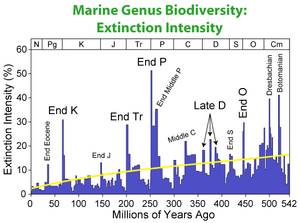
Comparison of the intensity of the T-J extinction event, labeled here "End Tr" to other extinction events in the last 500 million years. Data based on fossiliferous marine genera.
Ranges of families tetrapods through the Triassic and Early Jurassic
The Triassic-Jurassic extinction event occurred 200 million years ago and is one of the major extinction events of the Phanerozoic eon, profoundly affecting life on land and in the oceans. 20% of all marine families and all large Crurotarsi (non-dinosaurian archosaurs), some remaining therapsids, and many of the large amphibians were wiped out. At least half of the species now known to have been living on Earth at that time went extinct. This event opened an ecological niche allowing the dinosaurs to assume the dominant roles in the Jurassic period. This event happened in less than 10,000 years and occurred just before Pangaea started to break apart.
Several explanations for this event have been suggested, but all have unanswered challenges.
- Gradual climate change or sea-level fluctuations during the late Triassic. However, this does not explain the suddenness of the extinctions in the marine realm.
- Asteroid impact, but no impact crater can be dated to coincide with the Triassic-Jurassic boundary.
- Massive volcanic eruptions, specifically the flood basalts of the Central Atlantic Magmatic Province, would release carbon dioxide or sulfur dioxide which would cause either intense global warming (from the former) or cooling (from the latter).
However, the isotopic composition of fossil soils of Late Triassic and Early Jurassic show no evidence of any change in the CO2 composition of the atmosphere. More recently however, some evidence has been retrieved from near the Triassic-Jurassic boundary suggesting that there was a rise in atmospheric CO2 and some researchers have suggested that the cause of this rise, and of the mass extinction itself, could have been a combination of volcanic CO2 outgassing and catastrophic dissociation of gas hydrate. Gas hydrates have also been suggested as one possible cause of the largest mass extinction of all time; the so-called "Great Dying" at the end of the Permian Era.
External links
- Theories on the Triassic-Jurassic Extinction
- L.H. Tanner, S.G. Lucas, M.G. Chapman: "Assessing the record and causes of Late Triassic extinctions", Earth-Science Reviews 65 (2004) 103 – 139. [1]
- The Triassic-Jurassic Mass Extinction
- L. H. Tanner, J. F. Hubert, B. P. Coffey et al: "Stability of atmospheric CO2 levels across the Triassic/Jurassic boundary", NATURE 411 (2001) 7 JUNE 2001, 675-677.
- J. C. McElwain, D. J. Beerling, F. I. Woodward: "Fossil Plants and Global Warming at the Triassic-Jurassic Boundary" Science 27 August 1999: Vol. 285 (no. 5432), pp. 1386 - 1390.